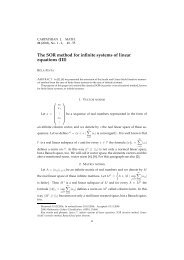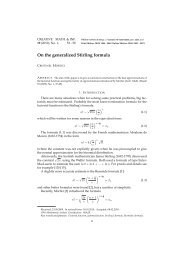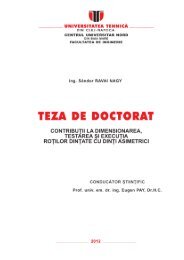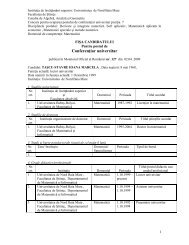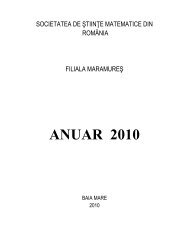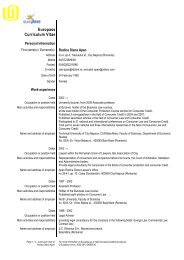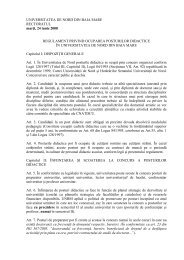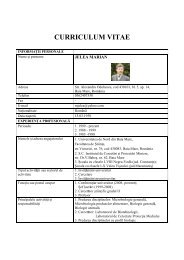Artin symbol of the Kummer fields - Creative Math. and Inf.
Artin symbol of the Kummer fields - Creative Math. and Inf.
Artin symbol of the Kummer fields - Creative Math. and Inf.
You also want an ePaper? Increase the reach of your titles
YUMPU automatically turns print PDFs into web optimized ePapers that Google loves.
64 Diana SavinProposition 1.1. ([5]). Let L/K be a Galois extension <strong>and</strong> Z K , Z l be <strong>the</strong> rings <strong>of</strong> algebraicintegers <strong>of</strong> <strong>the</strong> <strong>fields</strong> K <strong>and</strong> L.Let P ∈Spec(Z K ) such that <strong>the</strong> extension K⊂L is unramifiedin P. Let P ′ be a prime ideal in <strong>the</strong> ring Z L such that P ′ /P Z L . Then <strong>the</strong>re exists a uniqueautomorphism σ∈G(L/K) such that:σ(x) ≡ x N(P) (modP ′ ).Definition 1.2. ([1]). The element σ <strong>of</strong> <strong>the</strong> Proposition 1.1. is denotedIf <strong>the</strong> extension K⊂L is Abelian, <strong>the</strong>nbut only on P = P ′ ∩ Z K <strong>and</strong> it is denoted( )L/KP ′ (L/KP( )L/K.P ′does not depend on P ′ ∈Spec(Z L ),)Definition 1.3. ([1]). Let K⊂L be a Galois extension <strong>of</strong> <strong>fields</strong>, <strong>and</strong> let P ′ be a maximalideal in <strong>the</strong> ring Z L . The setZ P′ ={τ ∈ G(L/K)/τ(P ′ ) = P ′}is a subgroup in G(L/K) <strong>and</strong> it is called <strong>the</strong> group <strong>of</strong> decomposition <strong>of</strong> P ′ in <strong>the</strong>extension K ⊂ L.Theorem 1.4. ([1]). Let K⊂L be a Galois extension <strong>of</strong> <strong>fields</strong>, <strong>and</strong> let P be a maximal idealin <strong>the</strong> ring Z K .i) For any P ′ ∈Max P (Z L ) we have [G(L/K) : Z P′] = g P , where g P is <strong>the</strong> number <strong>of</strong>prime ideals fromZ L which divide P.ii) If(K⊂L is)a unramified in P <strong>and</strong> Abelian extension <strong>of</strong> <strong>fields</strong> <strong>and</strong> Z K /P is a finite field,<strong>the</strong>n L/Kgenerate <strong>the</strong> group ZP ′ P′ <strong>and</strong> |Z P′ | = f P′Proposition 1.2. ([6]). Let l be a prime natural number l ≥ 3 <strong>and</strong> ξ be a primitive root <strong>of</strong>unity <strong>of</strong> l- th order. A prime natural number p ≥ 3 is a prime in <strong>the</strong> ring Z [ξ] if <strong>and</strong> onlyif p is generating <strong>the</strong> group (Z ∗ l , ·)Let l be a odd prime natural number <strong>and</strong> ξ be a primitive root <strong>of</strong> unity <strong>of</strong> order l. Z [ξ]is <strong>the</strong> ring <strong>of</strong> integers <strong>of</strong> <strong>the</strong> cyclotomic field Q (ξ).Let p be a prime natural number, p≠l, <strong>and</strong> P be a prime ideal in <strong>the</strong> ring Z [ξ], P dividing<strong>the</strong> ideal generated by p, (p), in <strong>the</strong> ring Z [ξ].Proposition 1.3. ([3]). Let α ∈ Z [ξ], α/∈P. There is an integer c, unique modulo l, suchthat α N(P)−1l ≡ ξ c (modP ).Definition 1.4. ([3]). The root <strong>of</strong> unity ξ c is called <strong>the</strong> power-character <strong>of</strong> <strong>the</strong> numberα with respect{to <strong>the</strong> prime ideal P in <strong>the</strong> ring Z [ξ]. Following Hilbert([3]), weα}denote ξ c by .PProposition 1.4. ([3]). If α,β ∈ Z [ξ], (α), (β) are not divisible with P , <strong>the</strong>n:{ } αβ{ α} { } β= · .P P P
66 Diana SavinWe know that L/K is <strong>the</strong> trivial automorphism, <strong>the</strong>reforeqZ[ξ]( L/K) { }√( l p) = l√ p p = l√ p.qZ[ξ]qZ[ξ]{ } pThe case II: If ≠ 1, we obtain that f qZL = l.qZ[ξ]We denote( ) L/K √(qZ[ξ]l p) = ξc√ l p.Uging Proposition 1.1. we have:( ) L/K √(qZ l p) ≡ l√ N(qZ p L) (modqZ L ).LBut N(qZ[ξ]) = N(qZ L ),<strong>the</strong>reforeξ c l√ p ≡ l√ p N(qZ[ξ]) (modqZ L ).The last congruence implies that:l√ p(l√ p) N(qZ[ξ])−1 − ξ c) ≡ (modqZ L ).Since l √ p∈U(ZL ) <strong>and</strong> P ∈Spec(Z L ), it results that:This equality is equivalent with:√ qBut l p l−1 −1ll√ p N(qZ[ξ])−1 ≡ ξ c (modqZ L ).l√ pq l−1 −1l≡ ξ c (modqZ L ).− ξ c ∈Z[ξ] <strong>and</strong> qZ L ∩Z[ξ] = qZ[ξ], <strong>the</strong>refore we obtain:ql√ l−1 −1pl≡ ξ c (modqZ[ξ]).According to <strong>the</strong> Proposition 1.3. <strong>and</strong> Definion 1.4., we get that{ } pξ c = .qZ[ξ]From <strong>the</strong> previously proved, we obtain:( ) { }L/K √ p(qZ[ξ]l p) =qZ[ξ]l√ p.□We give now an application <strong>of</strong> <strong>the</strong> above result:
<strong>Artin</strong> <strong>symbol</strong> <strong>of</strong> <strong>the</strong> <strong>Kummer</strong> <strong>fields</strong> 67Proposition 2.9. Let p <strong>and</strong> l be odd prime distinct natural numbers, l ≡ 1(mod3)(,ǫ bea primitive root <strong>of</strong> order 3 <strong>of</strong> unity, K = Q (ǫ) be <strong>the</strong> cyclotomic field. Let L = Q ǫ; 3√ )lbe <strong>the</strong> <strong>Kummer</strong> field with <strong>the</strong> ring <strong>of</strong> integers A. If <strong>the</strong>re exist x,y∈N, p does not divide xsuch that p = x 3 + ly 3 , <strong>the</strong>n <strong>the</strong> <strong>Artin</strong> <strong>symbol</strong>:( ) L/K= 1 L ,P(∀) P ∈Spec(Z[ǫ]), P/pZ[ǫ].Pro<strong>of</strong>. We know that: pZ[ǫ] = P 1 ...P r , where P i ∈Spec(Z[ǫ]), i = 1,r, r =ϕ(3)ord (Z ∗3 ,·)p .We obtain that: if p ≡ 1(mod3) <strong>the</strong>n r = 2;if p ≡ 2(mod3) <strong>the</strong>n r = 1.The case I: p ≡ 1(mod3). We obtain that: pZ[ǫ] = P 1 P 2 , where P 1 , P 2 ∈Spec(Z[ǫ]).The equality p = x 3 + ly 3 is equivalent with:p = (x + √ 3ly)(x + ǫ 3√ ly)(x + ǫ 2 3√ ly). (2.1)Passing to <strong>the</strong> ideals in <strong>the</strong> ring A, in <strong>the</strong> equality (1), we have:P 1 A · P 2 A = (x + 3√ ly)A(x + ǫ 3√ ly)A(x + ǫ 2 3√ ly)A. (2.2)N(P 1 ) = N(P 2 ) = p f , where f is <strong>the</strong> inertial degree <strong>of</strong> P 1 , in <strong>the</strong> extension <strong>of</strong> <strong>fields</strong>Q ⊂ Q(ǫ).From <strong>the</strong> Theorem 1.3., we have that efg = [Q(ǫ) : Q] = 2. But g = 2,e = 1,<strong>the</strong>refore f = 1 <strong>and</strong> N(P 1 ) = N(P 2 ) = p.Using <strong>the</strong> Proposition 1.3. <strong>and</strong> <strong>the</strong> Definition 1.4., we have:{ } lBut ∈ { 1,ǫ,ǫ 2} , i = 1,2. We can have:P ioror{ lP i}≡ l p−13 (modPi ),i = 1,2. (2.3){ } l= ǫ c1 ≠ 1,P 1{ } l= ǫ c2 ≠ 1P 2{ } l= 1,P 1{ } l= ǫ c ≠ 1P 2{ } { } l l= = 1.P 1 P 2
68 Diana Savin{ } { }llIf = ǫ c1 ≠ 1, = ǫ c2 ≠ 1, using <strong>the</strong> Theorem 1.5., it resultsP 1 P 2P 1 A,P 2 A∈Spec(A).{ }This implies{that}<strong>the</strong> equality (2.2) is impossible. Therefore,llcannot have = ǫ c1 ≠ 1, = ǫ c2 ≠ 1.{ }P 1 { }P 2l lIf = 1, = ǫ c ≠ 1, usind <strong>the</strong> Theorem 1.5. we obtain thatP 1 P 2P 1 A = P 1P ′ 2P ′ 3, ′ where P ′ i ∈Spec(A) <strong>and</strong> P 2A∈Spec(A).Passing to <strong>the</strong> ideals in <strong>the</strong> ring A, in <strong>the</strong> equality (2.1), we have:P ′ 1P ′ 2P ′ 3(P 2 A) = (x + 3√ ly)A(x + ǫ 3√ ly)A(x + ǫ 2 3√ ly)A. (2.4)We know that p does not divide x, l ≡ 1(mod3) <strong>and</strong> we can prove easily that 3does not divide x + y, g.c.d.(x,y) = 1. According to <strong>the</strong> Proposition 1.7., <strong>the</strong> ideals(x + 3√ ly)A, (x + ǫ 3√ ly)A, (x + ǫ 2 3√ ly)Aare comaximal ideals in pairs.It is known that <strong>the</strong> Galois group G(L/K) is a cyclic group <strong>and</strong> let σ∈G(L/K),σ:L ↦→(L, σ(ǫ) = ǫ, σ( 3√ l) = ǫ 3√ l. We consider three cases.(i) If x + y 3√ )l A∈Spec(A), using <strong>the</strong> Proposition 1.6., we obtain that((σ x + y 3√ ) ) (l A = x + yǫ 3√ )l A ∈ Spec(A)<strong>and</strong>(( σ 2 x + y 3√ ) ) (l A = x + yǫ 2 3√ )l A ∈ Spec(A).This implies that <strong>the</strong> equality (2.4) is impossible. Similarly((we obtain that <strong>the</strong>equality (2.4) is impossible, in <strong>the</strong> case (ii) (when <strong>the</strong> ideal σ x + y 3√ ) )l A is aproduct((<strong>of</strong> two distinct prime ideals in <strong>the</strong> ring A) <strong>and</strong> in <strong>the</strong> case (iii) (when <strong>the</strong>ideal σ x + y 3√ ) )l A is <strong>the</strong> 2-power <strong>of</strong> a prime ideal in <strong>the</strong> ring A).{ {llIf = = 1, using <strong>the</strong> congruences (2.3) <strong>and</strong> <strong>the</strong> fact thatP 1}P 2}P 1 ,P 2 ∈Spec(Z[ǫ]), we obtain that:1 ≡ l p−13 (modpZ[ǫ]).But p,l∈N ∗ , <strong>the</strong>refore 1 ≡ l p−13 (modp).The last congruence is possible because p≡1(mod3).Since{ lP 1}={ } l= 1, using <strong>the</strong> Proposition 2.8., we obtain that:P 2( ) L/K= 1 L , (∀)i = 1,2P iThe case II: p ≡ 2(mod3). This implies that <strong>the</strong> ideal pZ[ǫ]∈Spec(Z[ǫ]).Similarly with <strong>the</strong> case I we obtain that N(pZ[ǫ]) = p 2 .
<strong>Artin</strong> <strong>symbol</strong> <strong>of</strong> <strong>the</strong> <strong>Kummer</strong> <strong>fields</strong> 69Using <strong>the</strong> Proposition 1.3. <strong>and</strong> <strong>the</strong> Definition 1.4., we have:{ } l≡ l p2 −13 (modpZ[ǫ]).pZ[ǫ]Since p <strong>and</strong> l are prime distinct natural numbers, it results that{ } lIf = ǫ c ≠ 1, hence pA∈Spec(A).pZ[ǫ]Passing to <strong>the</strong> ideals in <strong>the</strong> ring A, in <strong>the</strong> equality (1), we have:pA = (x + 3√ ly)A(x + ǫ 3√ ly)A(x + ǫ 2 3√ ly)A.The last equality is impossible. Therefore, we cannot have{ } l= ǫ c ≠ 1.pZ[ǫ]{ } lIf = 1 similar with <strong>the</strong> case I we obtain:pZ[ǫ]1 ≡ l p2 −13 (modpZ[ǫ]).But p, l p2 −13 ∈N ∗ , <strong>the</strong>refore 1 ≡ l p2 −13 (modp).From p≡2(mod3) results (p −1)/ p2 −1{ lpZ[ǫ]}= 1 implies that( L/KpZ[ǫ]{ } l≠ 0.pZ[ǫ]) 3. This implies that <strong>the</strong> last congruence is true.= 1 L . □REFERENCES[1] Albu T. <strong>and</strong> Ion D.I, Chapters <strong>of</strong> <strong>the</strong> algebraic <strong>the</strong>ory <strong>of</strong> numbers (in Romanian), Ed. Academiei,Bucureşti, 1984[2] Cohen H., A Course in Computational Algebraic Number Theory, Springer-Verlag, 1993[3] Hilbert D., The <strong>the</strong>ory <strong>of</strong> algebraic number <strong>fields</strong> (translated into Romanian), Ed. Corint, Bucureşti,1998[4] Irel<strong>and</strong> K. <strong>and</strong> Rosen M., A Classical Introduction to Modern Number Theory, Springer-Verlag, 1992[5] Magioladitis M., Primes <strong>of</strong> <strong>the</strong> form x 2 + ny 2 , University <strong>of</strong> Duisburg-Essen, June 2004[6] Savin D., About systems <strong>of</strong> Diophantine equations, Automation, Computers, Applied Ma<strong>the</strong>matics,13 (2004), 191-196.[7] Savin D., Using <strong>the</strong> properties <strong>of</strong> <strong>Kummer</strong> <strong>fields</strong> in <strong>the</strong> pro<strong>of</strong> on <strong>the</strong> diophantine equation x 4 − q 4 = py r ,Conference on Combinatorics, Automata <strong>and</strong> Number Theory, University <strong>of</strong> Liege, Belgium, May2006 (paper submitted)[8] Ştefănescu M., Galois Theory (in Romanian), Ed. Ex Ponto, Constanta, 2002[9] Stevenhagen P., <strong>Kummer</strong> Theory <strong>and</strong> Reciprocity Laws, Universiteit Leiden, 2005”OVIDIUS” UNIVERSITY OF CONSTANŢAFACULTY OF MATHEMATICS AND INFORMATICSDEPARTMENT OF MATHEMATICSBD. MAMAIA 124900527 CONSTANTA, ROMANIAE-mail address: savin.diana@univ-ovidius.roE-mail address: dianet72@yahoo.com



